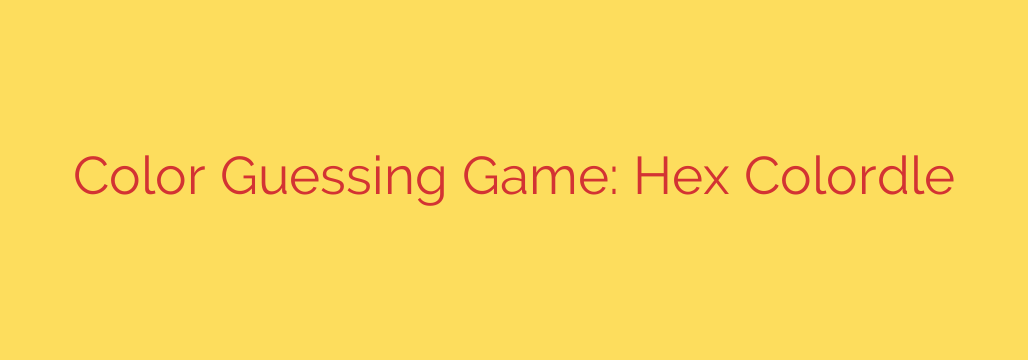
Hex Colordle: The Daily Color Guessing Game for Designers and Developers
Have you ever stared at a screen, trying to perfectly identify a specific shade of blue or a subtle off-white? For designers, developers, and digital artists, the ability to see and understand color is a crucial skill. Now, there’s a fun, challenging way to put that skill to the test and sharpen your color perception every day.
Enter Hex Colordle, the daily puzzle that’s becoming an essential brain teaser for anyone who works with color. Inspired by the viral success of Wordle, this game challenges you to guess a specific color’s hexadecimal code in just a few attempts. It’s simple, addictive, and surprisingly educational.
What Exactly is a Hex Code?
Before diving in, let’s quickly cover the basics. Hexadecimal, or hex, codes are six-digit codes used in web design and development to specify colors. Each code represents a unique combination of Red, Green, and Blue (RGB) light.
The code is structured as #RRGGBB, where RR represents the red value, GG the green, and BB the blue. The values range from 00 (no color) to FF (maximum color). For example, #FF0000 is pure red, #00FF00 is pure green, and #FFFFFF is pure white. Mastering these codes is key to winning the game.
How to Play the Game
The objective of Hex Colordle is straightforward: guess the correct hex code for the color displayed on the screen. You typically have five or six guesses to get it right.
- Observe the Target Color: You are presented with a solid block of the day’s target color.
- Enter Your Guess: Input a six-digit hex code for what you think the color is.
- Analyze the Feedback: After each guess, the game provides feedback on how close you are. This usually involves showing you the color your guess corresponds to and giving hints on the Red, Green, and Blue values—indicating if your numbers were too high or too low.
- Refine and Repeat: Use the feedback to adjust your next guess. If the game indicates your red value was too low, you’ll increase it in the next attempt. You continue this process until you either guess the exact code or run out of attempts.
The real challenge lies in translating your visual perception of a color into a precise series of numbers and letters.
Sharpen Your Skills: More Than Just a Game
While Hex Colordle is a fun daily distraction, its benefits go much deeper, especially for creative professionals.
- Improve Color Intuition: Regularly playing the game trains your brain to better associate visual colors with their underlying digital values. Over time, you’ll develop a more intuitive sense of what a color like
#3498DB(a common shade of blue) looks like without needing a color picker. - Memorize Key Hex Codes: The game is an excellent tool for memorizing important hex codes, such as brand colors, web-safe colors, or standard shades like black (
#000000) and white (#FFFFFF). - Understand Color Composition: By adjusting the RGB values with each guess, you gain a practical understanding of how red, green, and blue combine to create different hues, tints, and shades. This is fundamental knowledge for any form of digital design.
Tips and Strategies for Winning
Ready to test your skills? Here are a few strategies to improve your chances of guessing the correct hex code.
- Think in Components (RGB): Don’t just guess randomly. Try to deconstruct the color into its red, green, and blue components. Is it a warm color? It probably has a high red value. Is it a dark, muted green? The green value will be moderately high, but the red and blue values will be lower.
- Start with the Basics: If you’re stuck, start by guessing a primary color or a shade of gray (e.g.,
#808080). This can give you a solid baseline and help you determine which RGB values need the most adjustment. - Make Small, Deliberate Adjustments: Once you get feedback, change one component at a time. If the target is a shade of purple and your first guess was
#FF00FF(magenta), but the feedback says your blue is too high, try dialing it back to something like#FF00CC. - Learn the Hex Scale: Remember that
0is the lowest andFis the highest. The scale runs0, 1, 2, 3, 4, 5, 6, 7, 8, 9, A, B, C, D, E, F. Understanding this is crucial for making accurate adjustments.
Whether you are a seasoned web developer, a graphic designer, or simply a puzzle enthusiast looking for a new daily challenge, Hex Colordle offers a perfect blend of fun and practical skill-building. It’s a rewarding way to deepen your understanding of the digital spectrum one color at a time.
Source: https://www.linuxlinks.com/hex-colordle-color-guessing-game/








